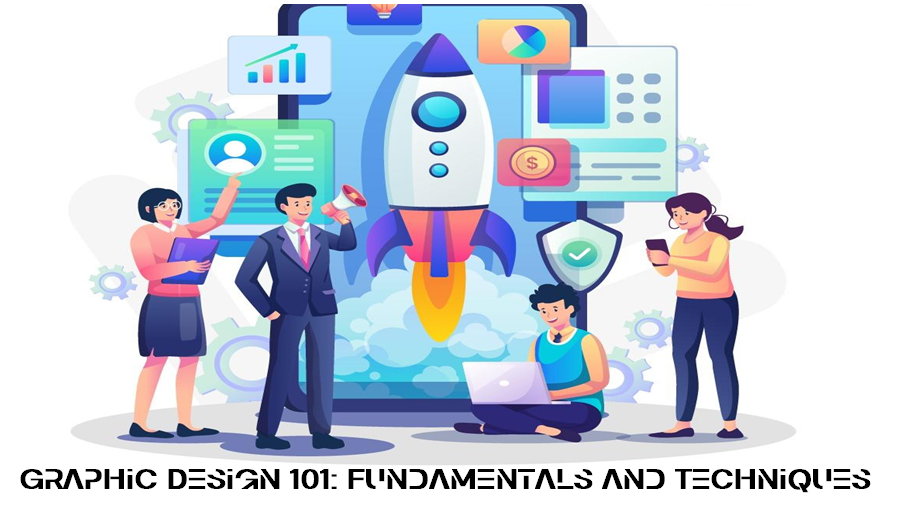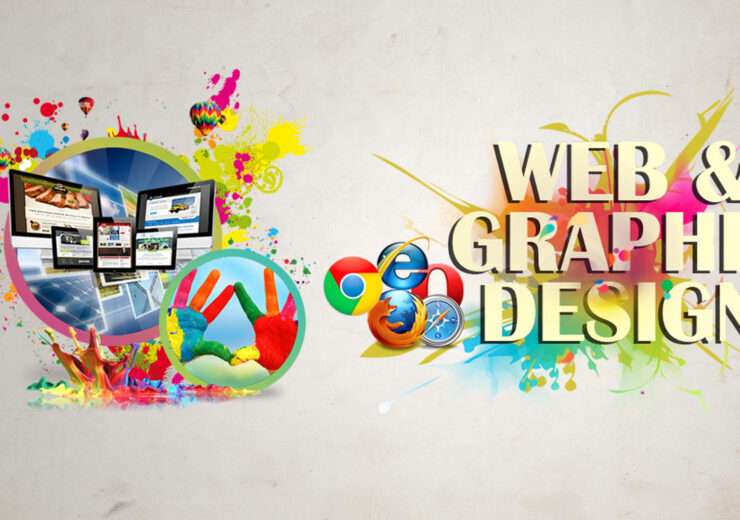Graphic Design 101: Fundamentals and Techniques

Welcome, graphic designers, to the world of design! Here we are, the best digital marketing agency in Indore, we believe that everyone has the potential to become a master of visual communication. We’ll delve into the core principles of design, explore industry-standard software, and unveil practical techniques to transform your ideas into stunning visual creations.
So put down the blank canvas and pick up your imagination! your reliable digital partner, and we will help you at every turn. Prepare to include your innovative aspect, become a professional in visual communication, and increase your. The purpose of this direction is to offer you foundational information on the fundamental principles and capabilities of picture design so you can create visually compelling messages.
So put down the blank canvas and pick up your imagination! your reliable digital partner and we will help you at every turn. Prepare to embrace your creative side, become an expert in visual communication, and advance your career—one eye-catching design at a time—by becoming the top digital marketing agency!
Module 1: Graphic Design Overview
————————————
- The art and practice of producing visual content to convey ideas is known as graphic design. It includes a broad range of fields, including illustration, motion graphics, photography, and typography.
The significant turning moments in graphic design history are listed below:
- The twentieth-century development of digital design tools
- Graphic design’s function in communication
Graphic design is essential to communication because it enables us to:
- Make defensible decision
- Comprehend complex information
- Experience feelings
- Act now
A range of visual components and methods are employed by graphic designers to produce compelling communication. These components may consist of:
- Pictures
- Forms
- Vibrant
- Typefaces
- Text The process of design
The design process is an organized method for producing visual designs. The following actions are usually involved:
- Describe the issue or goal.
- Make an investigation
- Develop concepts
- Make rough sketches.
- Improve the layout
- Display the completed design.
Module 2: Design Principles and Elements
————————————
Structure and composition
The arrangement of visual components to convey a sense of importance and order is known as hierarchy. The general layout of visual components on a page or screen is called composition.
Symmetry and equilibrium
The sense of visual equilibrium in a design is known as balance. The repetition of visual elements in mirror images is known as symmetry.
Emphasis and contrast
The distinction between two visual components is called contrast. The use of contrast to highlight a specific element is called emphasis.
Psychology and color theory
The study of how you can use colors to produce visual effects is known as color theory. The study of how colors influence & affect our feelings and actions is known as color psychology.
legibility and typography
The art and practice of arranging types is called typography. The ease with which a text can be read is known as legibility.
Module 3: Software Savvy – Your Digital Toolbox
————————————
Now that we’ve grasped the middle standards, let’s explore the gear that conveys your innovative visions to life. In this module, we will end up familiar with the industry-fashionable software program utilized by expert photograph designers:
- Adobe Photoshop: The undisputed king of image modification, Photoshop allows you to control snapshots, create illustrations, and build stunning visible compositions. From retouching pix to crafting surreal landscapes, Photoshop’s remarkable toolset unlocks countless possibilities.
- Adobe Illustrator: For vector pictures that scale infinitely, Illustrator reigns superbly. Create logos, icons, infographics, and problematic typography designs with razor-sharp precision. Explore the energy of Bézier curves, layer blending, and route outcomes to unharness your internal vector artist.
- Adobe InDesign: This web page layout powerhouse is your cross-to for crafting brochures, magazines, reports, and any other multi-page record you may consider. Master grid structures, paragraph styling, and image placement to lay out fascinating layouts that inform and encourage.
- Adobe XD: Prototyping and user interface layout take center stage with XD. Build interactive mockups of websites and cellular apps, take a look at user flows, and collaborate with developers to convey your virtual ideas to life.
- Remember, gaining knowledge of those tools is a non-stop journey. Don’t be afraid to test, play, and observe online tutorials to increase your software program competencies. The extra comfortable you turn out to be with your virtual toolbox, the more effects your creative ideas will be.
Module 4: Typography – The Art of Storytelling with Text
————————————
Words are effective, but, inside the palms of an expert dressmaker, they end up visible magic. Typography is an arranging type to create visually engaging and readable communications. Let’s delve into the important elements of typographic mastery:
- Font selection: Choose fonts that complement your design’s traditional subject matter and tone. Understand the distinction between serif and sans-serif fonts, test with formidable and italic variations, and discover the world of ornamental typefaces.
- Hierarchy and comparison: Use notable font sizes, weights, and spacing to create a visual hierarchy that courses the reader’s eye via your message. Play with contrasting patterns to emphasize key points and upload the seen hobby.
- Kerning and tracking: Adjust the distance between individual letters and words to make certain premier readability and visible concord. Don’t underestimate the energy of micro-adjustments in crafting an advanced typographic masterpiece.
- Color and texture: Don’t restrict yourself to black and white! Explore the effect of coloration, gradient overlays, and diffused textures on your typographic designs. Experiment with surprising combinations to create a super and noteworthy visible style.
Module 5: Mastering the Design Process – From Pixels to Perfection
————————————
Now that you’ve geared up yourself with the fundamentals and tools, it’s time to dive into the actual global application of your know-how. The layout manner is a structured yet bendy approach that allows you to translate your ideas into polished visuals.
- Define the brief: Every layout project begins with a clear knowledge of the hassle you’re trying to clear up. What is the message you need to deliver? Who is your target audience? What are the specific dreams and constraints of the venture?
- Research and brainstorm: Explore present designs, collect notions, and behavioral consumer studies to inform your innovative route. Sketch out difficult thoughts, test with special procedures, and do not be afraid to discard ideas that do not resonate.
- Refine and iterate: The beauty of design lies in its iterative nature. Once you have got a promising idea, begin building your virtual masterpiece. Use feedback loops, and behavior test runs, and do not hesitate to refine and alter your layout until it achieves its complete ability.
- Presentation and delivery: The final step is showcasing your work! Prepare polished mockups, present your design with confidence, and be prepared to answer questions and justify your design choices. Remember, communication is key in making your design ideas come to life.
Module 6: Design in the Digital Age – Web and Social Media Mastery
————————————
The graphic layout panorama extends far past print. In cutting-edge virtual global, gaining knowledge of internet and social media design is critical for any aspiring designer. Let’s explore important skills in this realm:
- Responsive layout: Adapt your designs to exceptional display screen sizes and devices, ensuring a continuing experience for cellular users in addition to computing device audiences.
- Social media pix: Capture attention inside the fast-paced international of social media. Design attractive banners, infographics, and posts that resonate with your target market and stand proud of the crowd.
- Video modifying and animation: Bring your designs to life with motion photos and short video clips. Explore structures like Adobe After Effects and Premiere Pro to add a dynamic measurement to your visual storytelling.
By adding case studies and examples relevant to our work as an Indore-based digital marketing agency, this course can be specifically customized for them.
Here are a few methods for achieving this:
- Utilize the color scheme and branding in all of the course materials.
- Display case studies of effective graphic design work that we have completed for customers.
- Talk about design issues and fixes that are pertinent to the field of digital marketing.
- Invite guest speakers to share their knowledge and perspectives.
- You can make sure that the course material is pertinent to our intended audience and advances its position as a frontrunner in the Indore digital marketing market by utilizing these keywords frequently.
Conclusion:
Starting Now, Take Your Graphic Design Journey from Pixels to Powerhouses
Best wishes! Graphic Design 101: Foundations and Techniques has come to an end. Keep in mind that graphic design is a process rather than a final goal.The top digital marketing agency in Indore, invites you to continue learning, practicing, and improving your abilities.
Never stop exploring new ideas, never stop learning, and never undervalue the impact of a well-designed image. You can turn your ideas into engrossing stories that connect with your audience and make an impression with commitment and passion.
Now go forth and rule the graphic design industry! Never forget that the top Indore digital marketing company is always available to help you along your creative path. We have faith in your abilities and can’t wait to see the incredible things you will produce!




